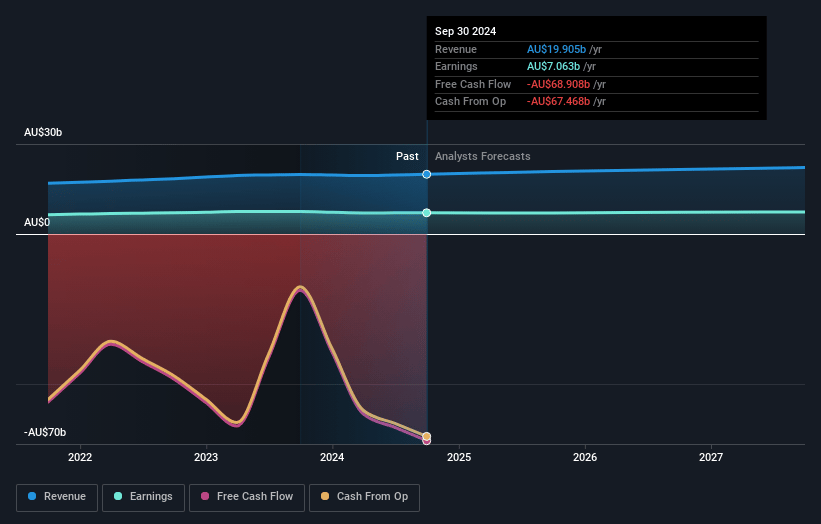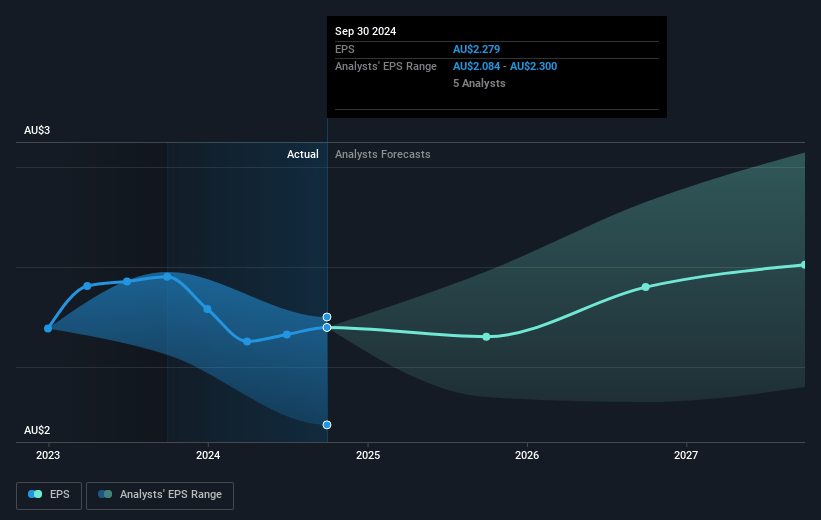Key Takeaways
- SME franchise growth and digitalization efforts could enhance revenue, efficiency, and net margins, strengthening NAB's position in Business and Private Banking.
- Risk management and strategic share buybacks focus on earnings stability and shareholder returns, with prudent balance sheet practices and improving cash ROE.
- Rising interest rates, competitive pressures, and asset quality concerns pose risks to NAB's revenue, margins, and profitability, with increased investments potentially heightening costs.
Catalysts
About National Australia Bank- Provides financial services to individuals and businesses in Australia, New Zealand, Europe, Asia, the United States, and internationally.
- The bank is focusing on enhancing its SME franchise and has seen significant growth in Business and Private Banking, indicating a potential for increased revenue and higher returns from this business segment.
- NAB's emphasis on digitalization and technology modernization, with specific investments in consumer tools and backend systems, suggests potential improvements in efficiency and cost management, potentially improving net margins.
- The strategy to grow deposit balances and improve deposit gathering, leveraging opportunities in both Personal and Business Banking, aims at mitigating interest rate impacts and stabilizing funding costs, which can positively affect earnings stability.
- The disciplined approach to risk management, including maintaining prudent balance sheet settings and strong provisioning coverage, positions the bank well for future macroeconomic challenges, potentially enhancing net margins through better asset quality management.
- NAB's ongoing share buyback program, which has improved cash ROE in fiscal 2024, indicates a strategic focus on improving shareholder returns through EPS growth by managing share count reduction.
National Australia Bank Future Earnings and Revenue Growth
Assumptions
How have these above catalysts been quantified?- Analysts are assuming National Australia Bank's revenue will grow by 3.5% annually over the next 3 years.
- Analysts assume that profit margins will shrink from 35.5% today to 33.3% in 3 years time.
- Analysts expect earnings to reach A$7.4 billion (and earnings per share of A$2.39) by about December 2027, up from A$7.1 billion today. However, there is some disagreement amongst the analysts with the more bearish ones expecting earnings as low as A$6.5 billion.
- In order for the above numbers to justify the analysts price target, the company would need to trade at a PE ratio of 17.3x on those 2027 earnings, up from 16.1x today. This future PE is greater than the current PE for the AU Banks industry at 12.5x.
- Analysts expect the number of shares outstanding to grow by 0.11% per year for the next 3 years.
- To value all of this in today's terms, we will use a discount rate of 7.09%, as per the Simply Wall St company report.
National Australia Bank Future Earnings Per Share Growth
Risks
What could happen that would invalidate this narrative?- The challenge of higher interest rates and the cost of living impacting customers could lead to increased customer defaults and impairments, which might negatively affect NAB’s revenue growth and net margins.
- Competitive pressures in home lending have resulted in lower revenue, highlighting a risk that ongoing competition could compress margins further, impacting overall earnings.
- Asset quality deterioration, particularly in the business and consumer portfolios, with noted risks in sectors such as construction and discretionary spending, could lead to higher credit impairment charges, affecting net margins and profitability.
- Significant reliance on broker channels for home lending exposes NAB to lower profitability relative to proprietary channels if market rates tighten further, impacting overall returns.
- Planned increases in investment spend, while essential for technology and customer experience upgrades, could place upward pressure on operating costs, affecting net margins if productivity savings are not realized as expected.
Valuation
How have all the factors above been brought together to estimate a fair value?- The analysts have a consensus price target of A$33.68 for National Australia Bank based on their expectations of its future earnings growth, profit margins and other risk factors. However, there is a degree of disagreement amongst analysts, with the most bullish reporting a price target of A$38.4, and the most bearish reporting a price target of just A$26.5.
- In order for you to agree with the analyst's consensus, you'd need to believe that by 2027, revenues will be A$22.1 billion, earnings will come to A$7.4 billion, and it would be trading on a PE ratio of 17.3x, assuming you use a discount rate of 7.1%.
- Given the current share price of A$37.2, the analyst's price target of A$33.68 is 10.4% lower. The relatively low difference between the current share price and the analyst consensus price target indicates that they believe on average, the company is fairly priced.
- We always encourage you to reach your own conclusions though. So sense check these analyst numbers against your own assumptions and expectations based on your understanding of the business and what you believe is probable.
How well do narratives help inform your perspective?
Disclaimer
Warren A.I. is a tool utilizing a Large Language Model (LLM) that ingests data on consensus price targets, forecasted revenue and earnings figures, as well as the transcripts of earnings calls to produce qualitative analysis. The narratives produced by Warren A.I. are general in nature and are based solely on analyst data and publicly-available material published by the respective companies. These scenarios are not indicative of the company's future performance and are exploratory in nature. Simply Wall St has no position in the company(s) mentioned. The price targets and estimates used are consensus data, and do not constitute a recommendation to buy or sell any stock, and they do not take account of your objectives, or your financial situation. Note that Warren A.I.'s analysis may not factor in the latest price-sensitive company announcements or qualitative material.
Read more narratives
There are no other narratives for this company.
View all narratives



